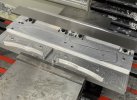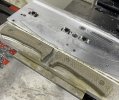Looking at this a little deeper now that I'm not on my phone.
To put it bluntly, I think buying that Tormach to 3D mill bevels will be a complete and total waste of your time and money. For $20k you could get a relatively late model used Tormach 1100 with a BT spindle or an older HAAS VF1 or VF2 with a 40 taper.
That said, if you toss the idea of machining bevels and use the machine for profiling blades, making holes, 3D milling handles and aluminum tooling for forming kydex, I think it would work out well for you. Here's the thing about CNC most people don't conceptualize. If you do *everything* in the machine, you have ass time. Now you might say that's ok because it's leisure time or design time or programming time. But by doing that you're severely extending the ROI on buying the machine. Because of how significantly, incredibly, painfully slow that machine would be at milling bevels, by moving that single operation to a grinder, you could double, triple, maybe quadruple your output. For example:
Simple 3 piece full tang fixed blade and sheath. You have the blade, two handle halves and the kydex. So at least 4 setups - but more than likely more depending how much machining you're going to do to each component.
Blade: Assume your stock is ground to thickness. You need to 1- drill some tooling holes in your stock. This could be done in the machine or manually on a drill press, they're not critical, they're just to hold your work down onto a fixture plate. Then before you machine the profile, you need to make holes for the handle. These need to be precise in form and position both for handle indexing, and to use as locating holes for flipping the blade over if you intend to machine bevels. You make those holes, and maybe some additional ones for lightening the tang. Option stop in the program to bolt down through those holes, so that your yet to be machined profiled knife doesn't fly away when you hit the last little bit of profile stock. Now you machine the profile. Depending on the material, hardness, thickness, etc variables, that 440 can probably do all this in lets say 1 hour. Option stop again and you remove the skeleton of material from the machine before you start beveling. Depending on the surface finish you want off the machine this could take anywhere from 1 hour and require A LOT of post processing finish work, or 8 hours with minute stepovers and spring passes for a next to complete surface finish. Then you have to flip it over and do it again. The point here, is that in that 2 to 16 hours of machine time to make bevels, there's likely no way that blade doesn't require post processing - at minimum it requires a micro bevel edge, but more than likely the surface finish on the bevel is so incongruent with the surface finish of the flats, you end up hand sanding or grinding it to something more palatable.
Handle pieces follow a similar process, at a far reduced time. From profiling to 3D contouring, you can run your machine probably 5 times faster because the material is so much easier to cut. So lets say from start to finish that's 1 hour of machine time for a finished handle. Your post processing could be nothing, like Carothers handle scales, or very simple, like a quick sandblasting or buffing. Either way very little manual time.
Sheath is even faster if you've made an aluminum mold. You manually press the mold, drop it on a fixture plate and in a generous 10 minutes have something ready to be assembled or folded at the seam.
Here's the thing, it would take me less than a hour to grind those bevels manually from stock to finish for a belt finish blade. Maybe 2 hours total for belt finish and hand sand. You have a minimum 1 hour run time for profiling and holemaking, 1 hour run time for the handles and 10 minutes for your sheath. Now you're building a complete knife every 2 hours and 15 minutes versus trying to get your little machine to run lights out and STILL require hand finishing.
I didn't run any simulations in CAM and I have a relatively simple knife in mind, so some of my estimates may be off, and you might say "well I don't care about production runs" - yep I get all that. The grander point still stands. 3D milling bevels is incredibly inefficient, and that machine is likely too small to do them the way (iirc) Carothers does them, with angled vise jaws and side milling, so if that's truly what you can afford, then you should look really hard at adding a grinder to your tooling list and do bevels outside of your machine. Because I understand this: "...from the model into an accurate physical manifestation as efficiently as possible, hence the determination to CNC" concept 100%, but the bevels themselves have little if any relationship to the other features modeled. Design your sheaths the right way and it won't matter one bit if there's some variability from knife to knife in the bevel. The handle doesn't care if this one is a saber grind and that one is a full flat grind or the next one is hollow ground. So there's little need to stabilize that process with CNC when the cost is so high to do so.
The knife I posted is probably the most expensive (cost) knife I've ever made. And I couldn't give it away

I think I got $250 for it.







